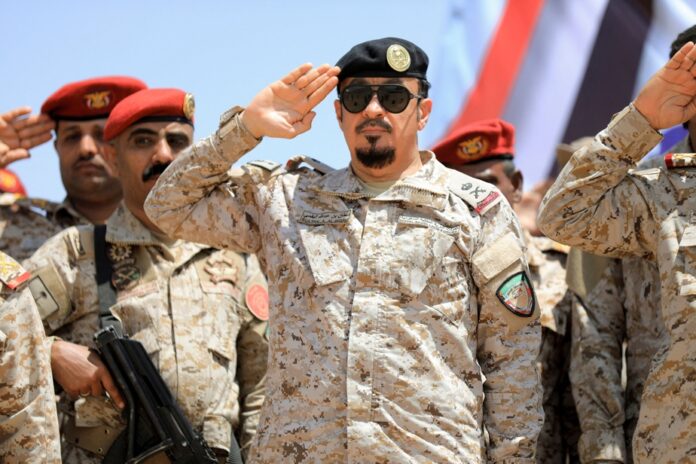(Sanaa) A rare Saudi delegation is in Sanaa to broker a lasting truce and discuss the peace process with Yemen’s Houthi rebels, after eight years of war and amid regional detente, Yemeni diplomatic sources said on Sunday.
Saudi officials, whose identity has not been revealed, came “to discuss ways to move forward towards the establishment of peace”, added these two diplomats working in the Gulf and who requested anonymity.
Houthi rebel officials and media announced the visit earlier in the day. Contacted by AFP, the Saudi authorities have not confirmed it.
Saudi officials have visited Sanaa in the past, but these visits are rare and often limited. But while Sunni Saudi Arabia has been trying for months to extricate itself from this quagmire, the recent rapprochement with its great Shia rival, Iran, has fueled hopes for appeasement in the Middle East, particularly in Yemen. .
On Saturday, Omani mediators also arrived in Sanaa to discuss with the Houthi rebels a truce with Saudi Arabia.
A truce was agreed a year ago in Yemen and has since been largely held, but was not officially renewed when it expired last October.
The poorest country on the Arabian Peninsula is suffering one of the worst humanitarian crises in the world. The war has left hundreds of thousands dead and millions displaced, with colossal challenges like epidemics, acute hunger and economic collapse, amid declining international aid.
A new truce under discussion includes demands long imposed by the rebels, Yemeni government sources told AFP.
Another demand is for the government to pay the salaries of all civil servants, including those working in Houthi-held areas.
On Saturday, the rebels also welcomed the release of 13 prisoners by Saudi authorities in exchange for a Saudi detainee, with Riyadh not commenting on the announcement.
In March, the Yemeni government and the rebels reached an agreement in Bern on an exchange of more than 880 prisoners.
“We want the war to end. We are tired,” Ali Hussein, a 23-year-old resident of the capital, told AFP.
Mahammed Dahmash, another 35-year-old resident, also told AFP he hoped “more than a truce, an agreement that will completely end the war”.
Yemen has been devastated by war since 2014.
The conflict between the Houthis, rebels close to Iran, and pro-government forces, supported by a military coalition led by neighboring Saudi Arabia, has left hundreds of thousands dead – direct or indirect victims – and millions displaced .
In July 2014, the Houthis, considering themselves marginalized, launched an offensive from their stronghold of Saada (north). They come from Zaidism, a branch of majority Shiism in the North and which represents more than 30% of the population of Yemen with a Sunni majority.
Allied with units loyal to ex-president Ali Abdallah Saleh, they entered the capital Sanaa in September and seized the seat of government.
They take the port city of Hodeida (west) on the Red Sea, then progress towards the center of the country.
In January 2015, they seized the presidential palace in Sanaa and surrounded the residence of President Abd Rabbo Mansour Hadi, who fled to Aden (south).
On March 26, 2015, a coalition led by Saudi Arabia, including the United Arab Emirates, launched an air operation to block the advance of the rebels. Washington provides logistical and intelligence support.
Mr. Hadi takes refuge in Saudi Arabia as the rebels approach Aden.
In July, the government announced the “liberation” of the province of Aden, the first success of the loyalists. The city of the same name becomes the “provisional” capital of power.
In early 2018, separatists from the South, an independent territory before its merger with the North in 1990, turned against government forces in Aden and besieged the presidential palace, before a Saudi-Emirati intervention.
In August 2019, clashes in Aden pitted separatists from the “Security Cord” force, trained by the Emirates, against government troops, supported by Riyadh.
Riyadh has since brokered a power-sharing deal and overseen the formation of a government.
On September 14, 2019, the rebels claimed responsibility for attacks against two sites of the oil giant Aramco in Saudi Arabia, the world’s largest exporter of crude oil. Riyadh and Washington accuse Iran, which denies it.
The Houthis are stepping up attacks with drones and missiles against the Saudi kingdom. In March 2021, Saudi oil facilities are the target of two major attacks.
After months of calm, the rebels resumed their offensive in February 2021 on Marib, a strategic city in an oil-rich region and the last loyalist stronghold in the North.
The offensive comes as the US administration of Joe Biden removed the Houthis from its list of “terrorist organizations”.
On January 17, 2022, the Houthis attack facilities in Abu Dhabi, killing three.
On the 25th, the rebels carried out new attacks in Saudi Arabia, causing a gigantic fire in an oil site in Jeddah.
A UN-brokered truce comes into effect on April 2, 2022. It expires six months later, on October 2, but the situation remains relatively calm on the ground.
On March 10, 2023, Saudi Arabia and Iran agreed, under the aegis of China, to resume their diplomatic relations and to reopen their embassies by mid-May.
On the 19th, Iranian President Ebrahim Raissi received an invitation from King Salman to go to Riyadh and seal the rapprochement between the two countries. The trip is planned after Ramadan, at the end of April.
On April 8, Omani mediators arrive in Sanaa to discuss with Houthi rebels a truce in Yemen with Saudi Arabia.
On April 9, a Saudi delegation arrives in Sanaa to negotiate a lasting truce and discuss the peace process with the Houthi rebels.


















